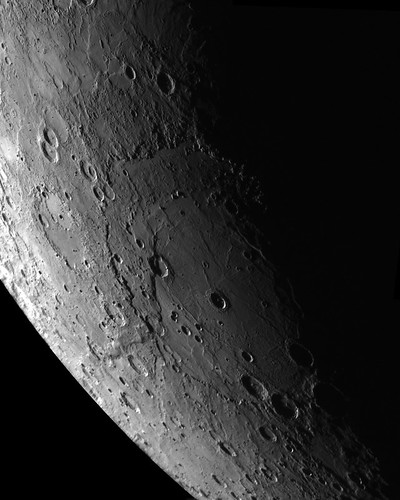Satellite News Bits
Tuesday, May 5th, 2009Satcom news summary for last week, courtesy of Bill McDonald:
Communications and Power Industries (CPI) wins three-year contract to supply high power, solid-state amplifiers to SWE-DISH, a DataPath company, for its Suitcase and CommuniCase product lines.
[SatNews – 05/01/2009]
Space Shuttle Atlantis to make final visit to Hubble telescope – launch to take place May 11.
[SatNews – 05/01/2009]
Eutelsat to launch Tooway broadband satellite service to UK residents in rural areas, initially with speeds of up to 2Mb, but by 2010 this will rise to 10Mb.
[Top 10 Broadband – 04/30/2009]
Soyuz to join Ariane 5 as launch vehicles lifting off from French Guiana, as Arianespace continues construction of the launch pad and support facilities.
[SatNews – 04/30/2009]
Zefiro 9A rocket motor, to be third stage of Europe’s new small launch vehicle, tested at Salto di Quirra Interforce test range in Sardinia, Italy.
[SatNews – 04/30/2009]
WildBlue Communications seeks a share of the U.S. government’s $7.2 billion broadband stimulus package to develop a new satellite-based platform that can deliver downstream speeds in excess of 18 Mbps to rural areas in need of a high-speed boost.
[Cable Digital News – 04/30/2009]
MacDonald, Dettwiler and Associates gets two nice wins – a $4m contract to provide an advanced technology solution to EADS Astrium, and a multi-million dollar contract from DigitalGlobe to provide a ground station solution for WorldView-1 and WorldView-2 satellites.
[SatNews – 04/30/2009]
Japanese government task force suggests introducing an early warning satellite that can detect missile launches as part of nations first basic plan on development and use of space.
[SatNews – 04/30/2009]
Iran states that the country’s first domestically-made telecommunications satellite, Omid, launched in February, has successfully concluded its mission and re-entered earth’s atmosphere.
[SatNews – 04/30/2009]
CPI will upgrade Army’s Warfighter Information Network-Tactical military satellite electronics to add Ka band satellite capability under $3m contract with DataPath.
[Military & Aerospace Electronics – 04/29/2009]
NASA prepares to launch nanosatellite known as PharmaSat to perform experiments to help scientists better understand how effectively drugs work in space.
[R&D – 04/29/2009]
Pentagon may reach goal of doing collision analysis on 800 maneuverable satellites before October, considers possibility of tracking 500 more satellites which cannot be maneuvered.
[SatNews – 04/29/2009]
Ducommun Incorporated announces that their Miltec subsidiary has delivered flight-ready nanosatellites to the U.S. Army Space and Missile Defense Command/Army Forces Strategic Command, completing first U.S. Army satellite development plan since 1960.
[SatNews – 04/29/2009]
Space and Aeronautics Subcommittee holds hearing to examine the challenges faced by civil and commercial space users as the number of satellites and the amount of space debris orbiting Earth continues to grow.
[SpaceRef.com – 04/28/2009]
International Space University students suggest ways to prevent space collisions in results of 2007 study released at "Space for a Safe and Secure World" symposium.
[SatNews – 04/28/2009]
Hughes wins arbitration against Sea Launch; Sea Launch ordered to pay $52m in dispute over whether Hughes had legal right to cancel Sea Launch contract.
[Satellite Today – 04/28/2009]
German teleport and satellite service provider CEDTel GmbH acquires ND SatCom Managed Services Division.
[SatNews – 04/28/2009]
The Australian Defence Force will spend $167 million for a special payload on the Intelsat 22 satellite to be launched in 2012, to boost its tactical communications for military serving in Afghanistan and nearby theatres in the Indian Ocean.
[The Australian – 04/28/2009]
Boeing wins contract to build satellite for Intelsat, to be launched in 2012, which will serve Australian military.
[The Detroit News – 04/28/2009]
Excelerate Technology wins contracts to provide satellite systems to enhance police communications capabilities in UK.
[Public Technology – 04/28/2009]
Nigeria National Assembly pledges to assist NIGCOMSAT to secure funding for NigComSat 2 & 3.
[Daily Trust – 04/28/2009]
Harbinger Capital Partners founder Philip Falcone presses ahead with multibillion-dollar plans to build international satellite-cellphone business.
[Wall Street Journal – 04/27/2009]
TerreStar satellite to be launched in June to be largest commercial satellite yet, with 60ft mesh antenna, to enable cell-like satellite phones; SkyTerra plans two even larger satellites next year.
[Seattle Times – 04/26/2009]
NSR Report – high throughput Ka-band spotbeam satellites pushing open satellite market door – full long-term potential to change market recognized by few.
[NSR report – April 2009]
WBMSAT PS – Satellite Communications Consulting Services


